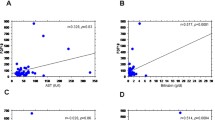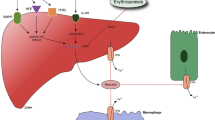Abstract
Fibroblast growth factor 21 (FGF21) is an adipokine and hepatokine, and its hepatic expression is induced in the injured liver. Adiponectin, whose systemic levels are positively correlated with measures of hepatic injury in patients with liver cirrhosis, is a downstream effector of FGF21. The aim of the present study was to identify possible associations of serum FGF21 with measures of liver function in patients with liver cirrhosis. FGF21 was determined by ELISA in serum of 42 patients. FGF21 was not linked to disease severity assessed by the Child–Pugh and MELD score. Levels were not changed in those patients with varices and/or ascites. Systemic FGF21 did not correlate with markers of liver and kidney function, inflammatory proteins or adipokines like adiponectin. Levels in hepatic and portal vein of 37 patients were also measured, but there was no transhepatic FGF21 gradient. Three months after insertion of a transjugular intrahepatic shunt hepatic venous pressure gradient was markedly improved, while FGF21 in serum of these 13 patients was not changed. The present study shows that hepatic release and systemic FGF21 are not linked to measures of liver function in patients with liver cirrhosis.




Similar content being viewed by others
References
D’Amico G, Garcia-Tsao G, Pagliaro L. Natural history and prognostic indicators of survival in cirrhosis: a systematic review of 118 studies. J Hepatol. 2006;44:217–31. doi:10.1016/j.jhep.2005.10.013.
Ge PS, Runyon BA. Treatment of patients with cirrhosis. N Engl J Med. 2016;375:767–77. doi:10.1056/NEJMra1504367.
Kawaratani H, Fukui H, Yoshiji H. Treatment for cirrhotic ascites. Hepatol Res. 2016;. doi:10.1111/hepr.12769.
Petrides AS, Vogt C, Schulze-Berge D, Matthews D, Strohmeyer G. Pathogenesis of glucose intolerance and diabetes mellitus in cirrhosis. Hepatology. 1994;19:616–27.
Carr RM, Correnti J. Insulin resistance in clinical and experimental alcoholic liver disease. Ann N Y Acad Sci. 2015;1353:1–20. doi:10.1111/nyas.12787.
Degre D, Gustot T, Gerkens A, et al. Insulin resistance is associated with esophageal varices in alcoholic liver disease patients. Eur J Gastroenterol Hepatol. 2016;28:792–6. doi:10.1097/MEG.0000000000000627.
Buechler C, Wanninger J, Neumeier M. Adiponectin, a key adipokine in obesity related liver diseases. World J Gastroenterol. 2011;17:2801–11. doi:10.3748/wjg.v17.i23.2801.
Holland WL, Miller RA, Wang ZV, et al. Receptor-mediated activation of ceramidase activity initiates the pleiotropic actions of adiponectin. Nat Med. 2011;17:55–63. doi:10.1038/nm.2277.
Eslam M, Ampuero J, Jover M, et al. Predicting portal hypertension and variceal bleeding using non-invasive measurements of metabolic variables. Ann Hepatol. 2013;12:588–98.
Kakizaki S, Sohara N, Yamazaki Y, et al. Elevated plasma resistin concentrations in patients with liver cirrhosis. J Gastroenterol Hepatol. 2008;23:73–7. doi:10.1111/j.1440-1746.2006.04757.x.
Kalafateli M, Triantos C, Tsochatzis E, et al. Adipokines levels are associated with the severity of liver disease in patients with alcoholic cirrhosis. World J Gastroenterol. 2015;21:3020–9. doi:10.3748/wjg.v21.i10.3020.
Kaser S, Moschen A, Kaser A, et al. Circulating adiponectin reflects severity of liver disease but not insulin sensitivity in liver cirrhosis. J Intern Med. 2005;258:274–80. doi:10.1111/j.1365-2796.2005.01543.x.
Kasztelan-Szczerbinska B, Surdacka A, Slomka M, et al. Association of serum adiponectin, leptin, and resistin concentrations with the severity of liver dysfunction and the disease complications in alcoholic liver disease. Mediat Inflamm. 2013;2013:148526. doi:10.1155/2013/148526.
Halberg N, Schraw TD, Wang ZV, et al. Systemic fate of the adipocyte-derived factor adiponectin. Diabetes. 2009;58:1961–70. doi:10.2337/db08-1750.
Wiest R, Moleda L, Farkas S, et al. Splanchnic concentrations and postprandial release of visceral adipokines. Metabolism. 2010;59:664–70. doi:10.1016/j.metabol.2009.09.011.
Tietge UJ, Boker KH, Manns MP, Bahr MJ. Elevated circulating adiponectin levels in liver cirrhosis are associated with reduced liver function and altered hepatic hemodynamics. Am J Physiol Endocrinol Metab. 2004;287:E82–9. doi:10.1152/ajpendo.00494.2003.
Dasarathy J, Alkhouri N, Dasarathy S. Changes in body composition after transjugular intrahepatic portosystemic stent in cirrhosis: a critical review of literature. Liv Int. 2011;31:1250–8. doi:10.1111/j.1478-3231.2011.02498.x.
Holland-Fischer P, Nielsen MF, Vilstrup H, et al. Insulin sensitivity and body composition in cirrhosis: changes after TIPS. Am J Physiol Gastrointest Liv Physiol. 2010;299:G486–93. doi:10.1152/ajpgi.00375.2009.
Thomsen KL, Sandahl TD, Holland-Fischer P, et al. Changes in adipokines after transjugular intrahepatic porto-systemic shunt indicate an anabolic shift in metabolism. Clin Nutr. 2012;31:940–5. doi:10.1016/j.clnu.2012.04.001.
Muise ES, Azzolina B, Kuo DW, et al. Adipose fibroblast growth factor 21 is up-regulated by peroxisome proliferator-activated receptor gamma and altered metabolic states. Mol Pharmacol. 2008;74:403–12. doi:10.1124/mol.108.044826.
Nishimura T, Nakatake Y, Konishi M, Itoh N. Identification of a novel FGF, FGF-21, preferentially expressed in the liver. Biochim Biophys Acta. 2000;1492:203–6.
Xu J, Lloyd DJ, Hale C, et al. Fibroblast growth factor 21 reverses hepatic steatosis, increases energy expenditure, and improves insulin sensitivity in diet-induced obese mice. Diabetes. 2009;58:250–9. doi:10.2337/db08-0392.
Quesada-Lopez T, Cereijo R, Turatsinze JV, et al. The lipid sensor GPR120 promotes brown fat activation and FGF21 release from adipocytes. Nat Commun. 2016;7:13479. doi:10.1038/ncomms13479.
Lin Z, Tian H, Lam KS, et al. Adiponectin mediates the metabolic effects of FGF21 on glucose homeostasis and insulin sensitivity in mice. Cell Metab. 2013;17:779–89. doi:10.1016/j.cmet.2013.04.005.
Cheng X, Vispute SG, Liu J, et al. Fibroblast growth factor (Fgf) 21 is a novel target gene of the aryl hydrocarbon receptor (AhR). Toxicol Appl Pharmacol. 2014;278:65–71. doi:10.1016/j.taap.2014.04.013.
Yang C, Lu W, Lin T, et al. Activation of liver FGF21 in hepatocarcinogenesis and during hepatic stress. BMC Gastroenterol. 2013;13:67. doi:10.1186/1471-230X-13-67.
Fisher FM, Chui PC, Nasser IA, et al. Fibroblast growth factor 21 limits lipotoxicity by promoting hepatic fatty acid activation in mice on methionine and choline-deficient diets. Gastroenterology. 2014;147(1073–83):e6. doi:10.1053/j.gastro.2014.07.044.
Rossle M, Gerbes AL. TIPS for the treatment of refractory ascites, hepatorenal syndrome and hepatic hydrothorax: a critical update. Gut. 2010;59:988–1000. doi:10.1136/gut.2009.193227.
Bauer S, Eisinger K, Wiest R, et al. Connective tissue growth factor level is increased in patients with liver cirrhosis but is not associated with complications or extent of liver injury. Regul Pept. 2012;179:10–4. doi:10.1016/j.regpep.2012.08.007.
Eisinger K, Krautbauer S, Wiest R, et al. Portal vein omentin is increased in patients with liver cirrhosis but is not associated with complications of portal hypertension. Eur J Clin Invest. 2013;43:926–32. doi:10.1111/eci.12122.
Eisinger K, Krautbauer S, Wiest R, Weiss TS, Buechler C. Reduced serum chemerin in patients with more severe liver cirrhosis. Exp Mol Pathol. 2015;98:208–13. doi:10.1016/j.yexmp.2015.01.010.
Wanninger J, Weigert J, Wiest R, et al. Systemic and hepatic vein galectin-3 are increased in patients with alcoholic liver cirrhosis and negatively correlate with liver function. Cytokine. 2011;55:435–40. doi:10.1016/j.cyto.2011.06.001.
Weigert J, Neumeier M, Wanninger J, et al. Systemic chemerin is related to inflammation rather than obesity in type 2 diabetes. Clin Endocrinol (Oxf). 2010;72:342–8. doi:10.1111/j.1365-2265.2009.03664.x.
Ahmadieh H, Azar ST. Liver disease and diabetes: association, pathophysiology, and management. Diabetes Res Clin Pract. 2014;104:53–62. doi:10.1016/j.diabres.2014.01.003.
Goral V, Atalay R, Kucukoner M. Insulin resistance in liver cirrhosis. Hepatogastroenterology. 2010;57:309–15.
Müller-Wieland D, Petermann A, Nauck M, Heinemann L, Kerner W, Müller UA, Landgraf R. Definition, klassifikation und diagnostik des diabetes mellitus. Diabetologie. 2016;11(Suppl 2):S78–81. doi:10.1055/s-0042-115159 (© Georg Thieme Verlag KG Stuttgart, New York, 2016).
Weiskirchen R, Tacke F. Liver fibrosis: from pathogenesis to novel therapies. Dig Dis. 2016;34:410–22. doi:10.1159/000444556.
Park HK, Ahima RS. Resistin in rodents and humans. Diabetes Metab J. 2013;37:404–14. doi:10.4093/dmj.2013.37.6.404.
Vashist SK, Venkatesh AG, Marion Schneider E, et al. Bioanalytical advances in assays for C-reactive protein. Biotechnol Adv. 2015;34:272–90. doi:10.1016/j.biotechadv.2015.12.010.
Ucar F, Sezer S, Ginis Z, et al. APRI, the FIB-4 score, and Forn’s index have noninvasive diagnostic value for liver fibrosis in patients with chronic hepatitis B. Eur J Gastroenterol Hepatol. 2013;25:1076–81. doi:10.1097/MEG.0b013e32835fd699.
Kukla M, Berdowska A, Stygar D, et al. Serum FGF21 and RBP4 levels in patients with chronic hepatitis C. Scand J Gastroenterol. 2012;47:1037–47. doi:10.3109/00365521.2012.694901.
Li H, Fang Q, Gao F, et al. Fibroblast growth factor 21 levels are increased in nonalcoholic fatty liver disease patients and are correlated with hepatic triglyceride. J Hepatol. 2010;53:934–40. doi:10.1016/j.jhep.2010.05.018.
Chavez AO, Molina-Carrion M, Abdul-Ghani MA, et al. Circulating fibroblast growth factor-21 is elevated in impaired glucose tolerance and type 2 diabetes and correlates with muscle and hepatic insulin resistance. Diabetes Care. 2009;32:1542–6. doi:10.2337/dc09-0684.
Lee Y, Lim S, Hong ES, et al. Serum FGF21 concentration is associated with hypertriglyceridaemia, hyperinsulinaemia and pericardial fat accumulation, independently of obesity, but not with current coronary artery status. Clin Endocrinol (Oxf). 2014;80:57–64. doi:10.1111/cen.12134.
Salman TA, Allam N, Azab GI, et al. Study of adiponectin in chronic liver disease and cholestasis. Hepatol Int. 2010;4:767–74. doi:10.1007/s12072-010-9216-0.
Hindricks J, Ebert T, Bachmann A, et al. Serum levels of fibroblast growth factor-21 are increased in chronic and acute renal dysfunction. Clin Endocrinol (Oxf). 2014;80:918–24. doi:10.1111/cen.12380.
Lin Z, Zhou Z, Liu Y, et al. Circulating FGF21 levels are progressively increased from the early to end stages of chronic kidney diseases and are associated with renal function in Chinese. PLoS ONE. 2011;6:e18398. doi:10.1371/journal.pone.0018398.
Matuszek B, Lenart-Lipinska M, Duma D, Solski J, Nowakowski A. Evaluation of concentrations of FGF-21—a new adipocytokine in type 2 diabetes. Endokrynol Pol. 2010;61:50–4.
Li X, Fan X, Ren F, et al. Serum FGF21 levels are increased in newly diagnosed type 2 diabetes with nonalcoholic fatty liver disease and associated with hsCRP levels independently. Diabetes Res Clin Pract. 2011;93:10–6. doi:10.1016/j.diabres.2011.02.034.
Pohl R, Haberl EM, Rein-Fischboeck L, et al. Hepatic chemerin mRNA expression is reduced in human nonalcoholic steatohepatitis. Eur J Clin Invest. 2017;47:7–18. doi:10.1111/eci.12695.
Berti L, Hartwig S, Irmler M, et al. Impact of fibroblast growth factor 21 on the secretome of human perivascular preadipocytes and adipocytes: a targeted proteomics approach. Arch Physiol Biochem. 2016;122:281–8. doi:10.1080/13813455.2016.1212898.
Imai K, Takai K, Hanai T, et al. Impact of serum chemerin levels on liver functional reserves and platelet counts in patients with hepatocellular carcinoma. Int J Mol Sci. 2014;15:11294–306. doi:10.3390/ijms150711294.
Sun B, Yang G, Yang M, et al. Long-term high-fat diet links the regulation of the insulin-sensitizing fibroblast growth factor-21 and visfatin. Cytokine. 2012;59:131–7. doi:10.1016/j.cyto.2012.03.030.
Gudowska M, Gruszewska E, Cylwik B, et al. Galectin-3 concentration in liver diseases. Ann Clin Lab Sci. 2015;45:669–73.
Yagmur E, Trautwein C, Gressner AM, Tacke F. Resistin serum levels are associated with insulin resistance, disease severity, clinical complications, and prognosis in patients with chronic liver diseases. Am J Gastroenterol. 2006;101:1244–52. doi:10.1111/j.1572-0241.2006.00543.x.
Benten D, Schulze zur Wiesch J, Sydow K, et al. The transhepatic endotoxin gradient is present despite liver cirrhosis and is attenuated after transjugular portosystemic shunt (TIPS). BMC Gastroenterol. 2011;11:107. doi:10.1186/1471-230X-11-107.
Acknowledgements
This study was in part supported by the “Stiftung für Pathobiochemie und Molekulare Diagnostik.”
Author information
Authors and Affiliations
Corresponding author
Ethics declarations
Conflict of interest
All authors declare that they have no conflict of interest.
Ethical approval
The study complies with the Declaration of Helsinki. All patients gave written informed consent, and the study was approved by the Ethical Committee of the University Hospital of Regensburg.
Rights and permissions
About this article
Cite this article
Krautbauer, S., Rein-Fischboeck, L., Haberl, E.M. et al. Circulating fibroblast growth factor 21 in patients with liver cirrhosis. Clin Exp Med 18, 63–69 (2018). https://doi.org/10.1007/s10238-017-0468-z
Received:
Accepted:
Published:
Issue Date:
DOI: https://doi.org/10.1007/s10238-017-0468-z




